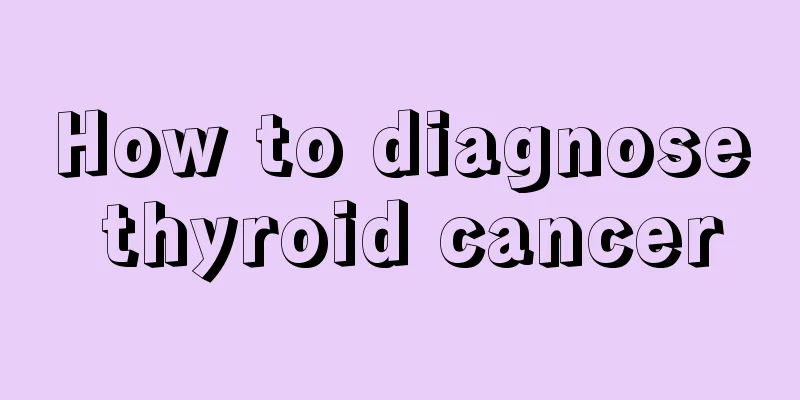How to diagnose thyroid cancer

|
How to diagnose thyroid cancer? Doing a good job in diagnosing and identifying thyroid cancer can ensure correct treatment, which is also a responsible performance for one's own health. So if you suspect that you have thyroid cancer, you should go to the hospital for diagnosis and treatment in time. So how to diagnose thyroid cancer? Differential diagnosis of thyroid cancer The thyroid gland is located under the throat at the front of the neck. It mainly secretes thyroid hormone to control the body's metabolism. The occurrence of thyroid cancer will have a serious impact on the patient's body metabolism. In severe cases, if metastasis occurs, it can also threaten the patient's life safety. 1. Nodular goiter Generally, there is iodine deficiency as the basis, which is more common in middle-aged women with a long medical history. The lesions often involve both sides of the thyroid gland and present as multiple nodules of different sizes, smooth and soft texture. The nodules generally have no compression symptoms. Some nodules undergo cystic changes and the glands may shrink symmetrically. The thyroid tumors increase rapidly and infiltrate the surrounding tissues. The tumors are firm and have poor mobility, and then metastasize to the deep cervical lymph nodes and supraclavicular lymph nodes. 2. Thyroiditis Various types of thyroiditis may be misdiagnosed as thyroid cancer, such as asymmetric enlargement of the thyroid gland, nodularity, adhesion and fixation to surrounding tissues, but the appearance under light microscopy is different. 1. Subacute thyroiditis It is often secondary to upper respiratory tract infection, destruction of thyroid follicles, release of colloid, fever, thyroid enlargement, hardening of one thyroid gland, accompanied by mild tenderness, and the other thyroid gland may be affected after a few weeks. Some cases may be relieved repeatedly within a few months, with serum T3, but the thyroid 131I absorption rate is significantly reduced. This separation phenomenon has diagnostic value. The treatment with adrenal cortex hormone and thyroxine supplementation is more effective. Most cases can be diagnosed based on typical clinical manifestations. 2. Chronic lymphocytic thyroiditis It mostly occurs in women over 40 years old. The disease is chronic on both sides of the thyroid gland, with rubber-like hardness and nodules on the surface. It is generally not adhered or fixed to the surrounding tissues, and there is no enlargement of the cervical lymph nodes. Some of them coexist with thyroid cancer, such as myxedema and significantly elevated thyroid antibodies. 3. Sclerosing thyroiditis Riedel disease Also known as fibrous thyroiditis, it is a local manifestation of a systemic chronic fibroproliferative disease, with an average duration of 2 to 3 years. The basal metabolism is normal or slightly higher. The thyroid gland is hard like wood, but the original shape of the thyroid gland is maintained. It is often fixed to the surrounding tissues and has compression symptoms, manifested as shortness of breath, which is difficult to distinguish from thyroid cancer. 3. Multiple endocrine neoplasia 1. MEN2A It is unilateral or bilateral adrenal pheochromocytoma. Most patients have a family history. Medullary carcinoma can be considered to exist in the C-cell proliferation stage, and then pheochromocytoma occurs and catecholamines are secreted. When catecholamines are abnormally increased, palpitations may occur, which may appear before medullary thyroid carcinoma. Pathological examination of local lesions can show amyloid deposition between the epidermis and dermis. The cause of occurrence is unknown, which may indicate medullary carcinoma. 2. MEN2B It is medullary thyroid cancer, including tongue dorsum or subconjunctival mucosal neuroma. Marfanoid body type is slender, with poor muscle development. Intestinal obstruction or diarrhea may occur, and metastasis occurs early. The lesions may have extended beyond the neck, but only a few are malignant, such as diarrhea. It is often bilateral and often due to sudden death of pheochromocytoma. Pheochromocytoma should be treated first, and medullary thyroid cancer should be removed at an appropriate time after surgery. Medullary thyroid cancer should be treated first. Hypercortisolism can often be relieved. The prognosis is poor. MEN2A type is better, and sporadic type is in the middle. |
<<: Do I need to take medicine after thyroid cancer surgery
>>: How long can you live with thyroid cancer
Recommend
What shoes should pregnant women wear in winter
Many pregnant women who become pregnant in the su...
What to do if liver cancer increases
Liver cancer is a malignant tumor of the digestiv...
How can young men prevent testicular cancer
Testicular cancer is a common malignant tumor dis...
What are the dangers of white precipitate in urine
Some patients with white precipitate in urine are...
Note on exercise after esophageal cancer surgery
Regular exercise during the recovery period after...
Are mouth ulcers serious? Pay attention to diet
Nowadays, people's diet quality is getting be...
What should I do if chewing gum is stuck on my shoes?
Chewing gum can help people remove bad breath in ...
How to preserve leftover avocados
If you cannot finish the avocado in one go, you s...
Suitable population and selection principles for cryosurgery of renal cancer
With the advancement of medical technology, inter...
What to do if your hands feel numb while sleeping due to cervical spondylosis
The incidence of cervical spondylosis is not only...
What are the measures to prevent lung cancer? You must know these things to prevent lung cancer
Lung cancer is a disease that makes many people f...
What are the names of stir-fried dishes
The most commonly eaten dish in our daily life is...
What to do if you wake up easily during sleep
Waking up easily during sleep is a common sleep d...
Modern Chinese Medicine for Brain Cancer Treatment
Traditional Chinese medicine has a long history o...
How to perform surgery on liver cancer? Analysis of surgical treatment methods for liver cancer
We may be familiar with liver cancer. There are m...









